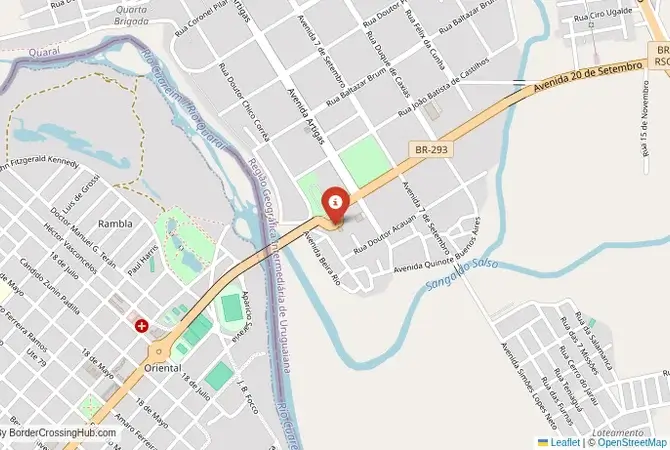
Approximate Border Location
Wait Times
30-60 min for pedestrians/vehicles
Operating Hours
Open 8:00 AM – 8:00 PM
Crossing Types
Pedestrians, vehicles
Border Type
Land crossing via bridge
Peak Times
Mornings (7-10 AM)
Daily Crossings
~2000 travelers/vehicles
Currency Exchange
Available near Quaraí (BRL, UYU)
Safety Information
Generally safe, beware touts
Languages Spoken
Portuguese, Spanish
Accessibility Features
Ramps, assistance
About Artigas & Quaraí
A Crossing in the Land of Amethysts
The border crossing connecting the Brazilian town of Quaraí with Artigas in Uruguay is a journey into the rural heartland of the Brazil-Uruguay frontier. This is a major international checkpoint, a bridge over the Quaraí (Cuareim) River that serves as a vital link for the agricultural and mining economies of the region. To cross here is to travel from the Brazilian pampas into a land famous for its world-class amethysts and agates. It is a passage that is less about urban integration and more about the deep, shared Gaúcho culture and the geological treasures that lie hidden beneath the rolling hills of this beautiful and less-traveled part of the border.
Operational Details
This checkpoint connects Brazil’s Rio Grande do Sul state with the Artigas Department of Uruguay. It is a major international crossing, open 24/7 to all passenger cars, buses, and commercial freight. The “Bridge of Concord” is a modern structure that spans the Quaraí River. The facility is designed to handle a significant volume of traffic, particularly the trucks that transport agricultural products and the famous semi-precious stones from the Artigas region. The crossing is a key link in the regional transport network, connecting the western part of Rio Grande do Sul with northwestern Uruguay.
Before Crossing
Crossing borders gets messy sometimes, think political flare-ups or gates shutting fast. Good travel insurance is a must for handling doctor visits, trip disruptions, or security scares. Don’t get caught unprepared. To find a policy that’s got your back, check out reliable plans today for peace of mind.
A History of a Gaúcho Heartland
The history of this region is the history of the Pampa, the vast grasslands that are the heartland of the Gaúcho (Gaucho in Spanish) culture. This has been a land of cattle ranching and a contested frontier between the Spanish and Portuguese empires for centuries. The modern border was established in the 19th century, but the shared Gaúcho culture, with its traditions of horsemanship, barbecue (churrasco/asado), and mate (chimarrão/mate), has always transcended the political line. The two towns grew up as important centers for the surrounding agricultural communities. The discovery of rich deposits of amethysts and agates in the Artigas region in the late 19th century added a new and unique dimension to the local economy.
Border Crossing Procedure
The border crossing procedure is a standard two-part process. You will first complete exit formalities at one country’s checkpoint and then proceed across the bridge to the other country’s checkpoint for entry inspection. You will need a valid passport or, for citizens of Mercosur countries, a national ID card. Vehicle registration and international insurance (Carta Verde) are also necessary. The process is generally straightforward, and the checkpoint is equipped to handle a steady flow of traffic. Queues can form, but they are generally less severe than at the main coastal crossings.
The Surrounding Region: Brazil Side
On the Brazilian side, Quaraí is a quiet, pleasant town that serves as a commercial center for the surrounding agricultural region. It is known for its annual literary festival, the “Feira do Livro.” The region is part of the “Campanha Gaúcha,” the Brazilian pampas, an area of vast, open landscapes and large cattle ranches. The town has a strong traditionalist Gaúcho culture, with numerous “CTG” (Centers of Gaúcho Traditions) that preserve the music, dance, and customs of the region.
The Surrounding Region: Uruguay Side
On the Uruguayan side, the city of Artigas is the main attraction. It is the center of Uruguay’s gemstone industry. The region is famous for producing some of the highest quality and most intensely colored amethysts in the world. Visitors can tour the mines, visit workshops where the stones are cut and polished, and buy gemstones and jewelry at very competitive prices. The city also has a charming central plaza and is a vibrant commercial hub for northwestern Uruguay. The annual carnival in Artigas is famous for its samba schools, which are heavily influenced by the nearby Brazilian culture.
Practical Travel Information
Practical planning for this route is straightforward. The main road is well-maintained. The official currencies are the Brazilian Real (BRL) in Brazil and the Uruguayan Peso (UYU) in Uruguay. Services are available in the towns on both sides of the border. Ensure your vehicle’s Carta Verde insurance is valid for both countries. This crossing is an excellent choice for an alternative, less-traveled route into Uruguay, especially for those interested in the unique attraction of the amethyst mines.
Final Considerations
The Quaraí–Artigas border crossing is a journey into the heart of the Gaúcho pampas and a land of geological treasures. It is a busy, functional checkpoint that serves as a vital link for the agricultural and mining economies of the region. It offers a passage through a shared landscape of rolling hills and a deep, intertwined culture. For the traveler, it is a gateway to the unique and beautiful world of amethysts, a chance to explore a less-visited but fascinating corner of the Brazil-Uruguay frontier.
No reviews yet.
